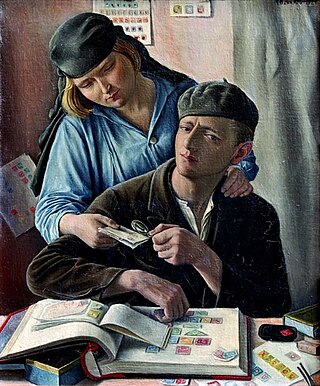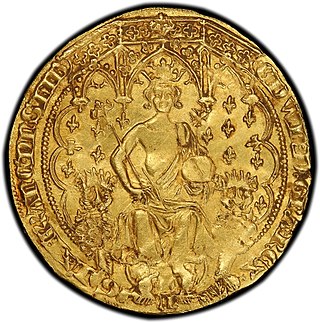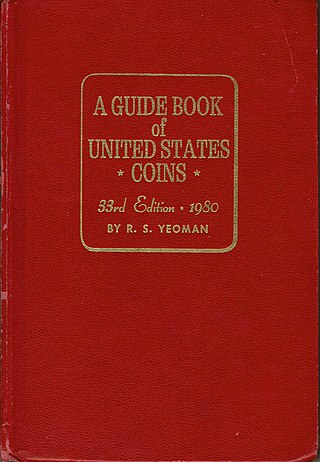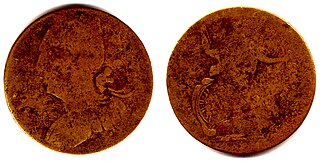A coin catalog (or coin catalogue) is a listing of coin types. Information may include pictures of the obverse and reverse (front and back), date and place of minting, distribution type, translation of inscriptions, description of images, theme, metal type, mintage, edge description, orientation of the coin, weight, diameter, thickness, design credentials, shape and prices for various grades. Defects may also be described. [1]
The quality, detail and completeness of the information available about a particular coin varies according to popularity, commonality, and available scholarly research. Because of the huge number of coins in world history, there are no comprehensive catalogs. Professional collectors typically keep many books for identification and assessment. The other form is the auction catalog, where only those specific coins available in the auction are described, with photo plates available for some of the more prominent coins.

Coin collecting is the collecting of coins or other forms of minted legal tender. Coins of interest to collectors include beautiful, rare, and historically significant pieces. Collectors may be interested, for example, in complete sets of a particular design or denomination, coins that were in circulation for only a brief time, or coins with errors. Coin collecting can be differentiated from numismatics, in that the latter is the systematic study of currency as a whole, though the two disciplines are closely interlinked.

Stamp collecting is the collecting of postage stamps and related objects. It is an area of philately, which is the study of stamps. It has been one of the world's most popular hobbies since the late nineteenth century with the rapid growth of the postal service, as a stream of new stamps was produced by countries that sought to advertise their distinctiveness through their stamps.

Philatelic literature is written material relating to philately, primarily information about postage stamps and postal history.

Bibliography, as a discipline, is traditionally the academic study of books as physical, cultural objects; in this sense, it is also known as bibliology. English author and bibliographer John Carter describes bibliography as a word having two senses: one, a list of books for further study or of works consulted by an author ; the other one, applicable for collectors, is "the study of books as physical objects" and "the systematic description of books as objects".

The English florin, sometimes known as the double leopard, was an attempt in 1344 by Edward III to produce gold coinage suitable for use in Europe as well as in England. It was authorised on 27 January 1344, and struck from 108 grains of nominal pure ('fine') gold and had a value of six shillings.

An auction catalog or auction catalogue is inventory of listing of items to be sold at an auction. It is made available some time before the auction date. Auction catalogs for rare and expensive items, such as art, books, jewelry, postage stamps, furniture, wine, cars, posters, published for sales around the world, can be of interest in themselves--they will can include detailed descriptions of the items, their provenance, historical significance, photographs, and even comparative analyses and descriptive essays by subject experts.

A stamp catalog is a catalog of postage stamp types with descriptions and prices.

Notaphily is the study and collection of paper currency, and banknotes. A notaphilist is a collector of banknotes or paper money, particularly as a hobby.

Anglo-American Cataloguing Rules (AACR) were an international library cataloging standard. First published in 1967 and edited by C. Sumner Spalding, a second edition (AACR2) edited by Michael Gorman and Paul W. Winkler was issued in 1978, with subsequent revisions (AACR2R) appearing in 1988 and 1998; all updates ceased in 2005.

The Canadian five-cent coin, commonly called a nickel, is a coin worth five cents or one-twentieth of a Canadian dollar. It was patterned on the corresponding coin in the neighbouring United States. It became the smallest-valued coin in the currency upon the discontinuation of the penny in 2013. Due to inflation, the purchasing power of the nickel continues to drop and currently the coin represents less than 0.5% of the country's lowest minimum hourly wage.

The Canadian fifty-cent coin is a Canadian coin worth 50 cents. The coin's reverse depicts the coat of arms of Canada. At the opening ceremonies for the Ottawa branch of the Royal Mint, held on January 2, 1908, Governor General Earl Grey struck the Dominion of Canada's first domestically produced coin. It was a silver fifty-cent coin bearing the effigy of King Edward VII.
Comic book price guides are typically published on a monthly, quarterly, or yearly basis and provide comprehensive information about the fluctuations in the resale value of comics over a specific duration. These guides play a crucial role for collectors who intend to sell their collection or require an estimate of their collection's value for insurance purposes.

In library and information science, cataloging (US) or cataloguing (UK) is the process of creating metadata representing information resources, such as books, sound recordings, moving images, etc. Cataloging provides information such as author's names, titles, and subject terms that describe resources, typically through the creation of bibliographic records. The records serve as surrogates for the stored information resources. Since the 1970s these metadata are in machine-readable form and are indexed by information retrieval tools, such as bibliographic databases or search engines. While typically the cataloging process results in the production of library catalogs, it also produces other types of discovery tools for documents and collections.

A Guide Book of United States Coins (The Official Red Book), first compiled by R. S. Yeoman in 1946, is a price guide for coin collectors of coins of the United States dollar, commonly known as the Red Book.
Group races, also known as Pattern races, or Graded races in some jurisdictions, are the highest level of races in Thoroughbred horse racing. They include most of the world's iconic races, such as the Derby, Irish Derby and Prix de l'Arc de Triomphe in Europe, the Melbourne Cup in Australia, and the Kentucky Derby and Breeders' Cup races in the United States. Victory in these races marks a horse as being particularly talented, if not exceptional, and they are extremely important in determining stud values. They are also sometimes referred to as Black type races, since any horse that has won one of these races is printed in bold type in sales catalogues.
The Charlton Press is a book publishing company that produces pricing guides as well as other books on related topics, including collectibles and porcelain figures. The company's first title was Catalogue of Canadian Coins, Tokens & Fractional Currency, published in 1952, and contained all coins used as circulating tender in Canada from 1858 until present.

Krause Publications, an American publisher of hobby magazines and books, was originally founded and based in Iola, Wisconsin. However, in April 2018, they relocated to Stevens Point, Wisconsin.
The Standard Catalog of World Coins is a series of numismatic catalogs, commonly known as the Krause catalogs. They are published by Krause Publications, a division of Active Interest Media.

The Treasury Note was a type of representative money issued by the United States government from 1890 until 1893 under authority of the Sherman Silver Purchase Act in denominations of $1, $2, $5, $10, $20, $50, $100 and $1,000. It was issued in two series: an 1890 series with $1, $2, $5, $10, $20, $100 and $1,000 denominations, and an 1891 series that added the $50 denomination. A $500 note was designed but never issued.

Blacksmith tokens are a form of evasion currency that was in circulation primarily in Lower Canada and Upper Canada along with neighboring areas, such as the northern parts of New York and New England in the mid-1820 to 1830s. They were not, strictly speaking counterfeits, but instead skirted around the laws of the time by being similar to officially circulating coinage, but bearing different legends, or bearing no legends or dates at all, so it could not be claimed that they were truly imitating circulating coinage fully. The tokens were designed to resemble worn examples of English or Irish copper coinage, most often with a crude profile of either George II or George III in profile on the obverse and an image of Britannia or an Irish harp on the reverse. They were typically underweight when compared to officially sanctioned halfpenny coinage, but were accepted along with many other unofficially issued tokens due to a lack of sufficient small denomination coinage in circulation at the time.